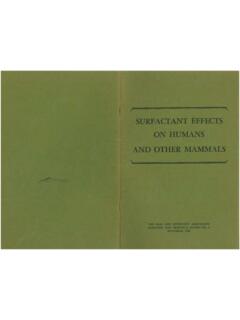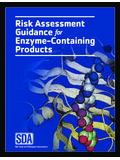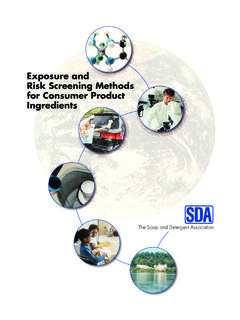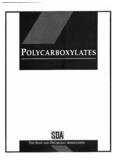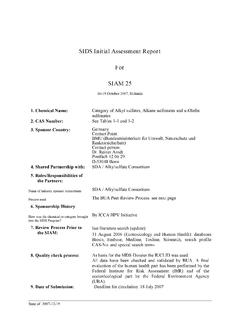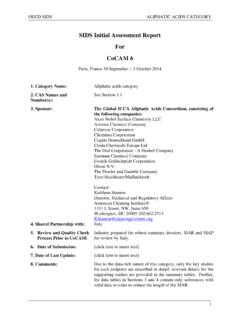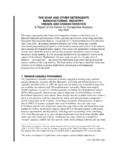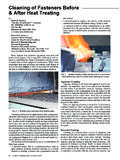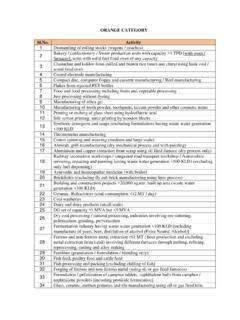Transcription of Chemital Description - Cleaning Institute
1 This monograph summarizes: I) critical fate and effects data required for an environmental risk assessment on sodium hypochlorite ; and 2) conclusions drawn from a risk assessment of sodium hypochlorite in the United States. Although focused on conditions in the , data from other parts of the world that are relevant to a assessment are included in the monograph. The monograph is written for a technical audience, but not necessarily one familiar with environmental risk assessment. The monograph is formatted into five sections. The first section describes sodium hypochlorite , its chemical structure and consumption volumes. The second section describes the function of sodium hypochlorite in Cleaning products.
2 The third section describes its fate and exposure concentrations in the environment. The fourth section presents environmental effects information. The fifth section presents a comparison of exposure and effects concentrations in the framework of an environmental risk assessment. The Soap and Detergent Association and its member companies do not make any warranties, expressed or implied, with respect to the accuracy or completeness of the information con- tained herein, and assume no responsibility or liability for the use of the information. Neither do The Soap and Detergent Association nor its member companies assume any responsibility to amend, revise or update information contained herein based on information which becomes available subsequent to publication.
3 O 1997 The Soap and Detergent Association This paper is made from 50% recycled fibers that include 10% post consumer waste. Chemital Description sodium hypochlorite , NaOC1, better known as bleach, is an inorganic oxidizing agent. It is registered in the Toxic Substances Control Act (TSCA) Chemical Substance Inventory as hypochlorous acid, sodium salt ( ) and is identified with the Chemical Abstracts Service (CAS) Registry Number 768 1-52-9. sodium hypochlorite is formed under controlled conditions by reacting chlorine with aqueous solutions of sodium hydroxide as follows: 2 NaOH + C1,- NaOCl + NaCl + H20 A small excess of sodium hydroxide is required to maintain the pH of sodium hypochlorite solutions between 11 and 13, thereby minimizing the decomposition of the sodium hypochlorite .
4 hypochlorite also decomposes as a result of catalysis by metal ions such as nickel, cobalt, iron and copper: M "+ 20c1- - 2 c1- + 0, This reaction will lower the sodium hypochlorite concentration in a product, potentially reducing the product's performance, and produce oxygen gas which, if it occurs during storage, may deform or damage a closed container. That is why sodium hypochlorite solutions need to be measured as percent "available" chlorine. The percent available chlorine is 95% of the weight percent of sodium hypochlorite . "Available" chlorine is the equivalent concentration of chlorine needed to make sodium hypochlorite as shown above. Consumption Approximately 500 million to 600 million pounds of sodium hypochlorite were produced and consumed in the in 1990 (Peters, Riepl, Leder and Sasano, 1992).
5 About 40% is manufactured at sodium hypochlorite , which is typical household strength. Many household Cleaning products contain various concentrations of sodium hypochlorite . Drain openers, disinfectants, mildew stain removers and general purpose cleaners may contain 1-7% sodium hypochlorite . The remainder of the sodium hypochlorite is produced at industrial strength, 15-20% sodium hypochlorite . Industrial uses include drinking water, wastewater and swimming pool disinfection, and textile bleaching. Function sodium hypochlorite reacts rapidly with a wide variety of inorganic and organic compounds. As a result, it is an effective stain remover, cleaner, sanitizer and disinfectant. Major uses of industrial strength sodium hypochlorite include disinfection of swimming pool water and waste- water generated by both municipalities and industry, and bleaching of chemical pulp, textiles and commercial laundry (Peters et al.)
6 , 1992). sodium hypochlorite bleach was introduced to consumers in 1916. Today, it is used in four out of five households in the (The Clorox Company, 1991). The major household use of sodium hypochlorite bleach is in laundering. Bleach boosts the Cleaning power of all detergents. This is particularly important in cool water temperatures and in hard water. sodium hypochlorite also ensures the destruction of contaminant microorganisms from Cleaning towels, dish cloths, cloth diapers, etc. sodium hypochlorite is one of the most effective disinfectant and bleaching agents known (Bloomfield, 1978; FIFE-AIS, 1993). It has broad spectrum action, being effective against bacteria (both Gram positive and Gram negative), bacterial spores, viruses and fungi both in laundry and on household surfaces.
7 In addition to launder- ing, sodium hypochlorite bleaches are used to remove stains and soil, clean, sanitize and disinfect toilets, sinks, floors, showers, kitchen counters and other household surfaces. Bleach is also a deodorizer, killing the bacteria that cause odors and aiding in removing the soils that contribute to the odors themselves. sodium hypochlorite is approved for specific uses by the Environmental Protection Agency, Department of Agriculture and the Food and Drug Administration. These uses include disinfection of food and nonfood contact surfaces, including households and laundry ( EPA, 1991; Cook, Hasler, Kim, deleeuw, McCabe, Meehan, Mitchell, Shaheen, Smith and Stanislowski, 1996), dairy equipment ( EPA, 1992), and washing fruit and vegetables ( EPA, 1992; Department of Agriculture, 1991; Food and Drug Administration, 1991).
8 sodium hypochlorite is also used for a variety of sanitizing and disinfecting purposes in agriculture ( EPA, 1991; EPA, 1992). In the medical area, sodium hypochlorite bleach is used to disinfect kidney dialysis machines ( EPA, 1992), to disinfect work surfaces in medical laboratories ( EPA, 1992), and by dentists in the treatment of gum disease and root canals (Gilman, Goodman and Gilman, 1980). Mechanism In water, sodium hypochlorite exists as sodium , Na', and hypochlorite , OCl-, ions. The hypochlorite ions are also in equilibrium with hypochlorous acid, as shown in the following equation: OCI- + H+ -+ HOCl The relative amounts of hypochlorite ions and hypochlorous acid vary with pH (Jolley and Carpenter, 1981).
9 HOCl will predominate below pH , while OC1- is predominant above this pH. Both HOCl and OCI- are oxidizing species. The HOCl form is a stronger oxidant than the less electrophilic OC1-. sodium hypochlorite and other products which produce hypochlorite species, such as chlorinated isocyanurates, hydantoin and calcium hypochlorite , will react rapidly with oxidizable inorganic and organic compounds (soils, stains), predominantly through nucleophilic or electron transfer reactions yielding primarily sodium chloride as the chlorine-containing product. sodium hypochlorite may also react with some organic compounds to form small amounts of chlorinated organic compounds (Jolley et al., 1981). Fate The route of environmental release of sodium hypochlo- rite from use in Cleaning products is down-the-drain, with the product and/or its by-products being treated by on-site or municipal waste treatment systems.
10 Studies conducted with bleached laundry wash water suggest that approxi- mately 12% of the chlorinated organic are volatile and that the majority of these volatile compounds, greater than 70%, remain in solution during the wash cycle (Ong, DeGraeve, Silva-Wilkinson, McCabe and Smith, 1996). The fate of sodium hypochlorite during use and discharge to sewer systems has been investigated (FIFE-AIS, 1993; Consultative Expert Group Detergents- Environment, 1989). These studies reveal that hypochlo- rite is rapidly consumed, predominantly through oxidation reactions, with inorganic compounds and organic substances found in wash water and wastewater, and is converted to chloride. The rapid reactivity of sodium hypochlorite with the high concentrations of inorganic and organic materials already present in wastewater makes sodium hypochlorite safe for biological treatment plants.
